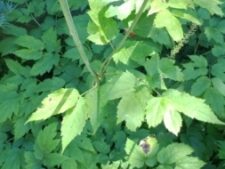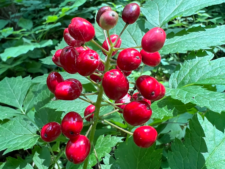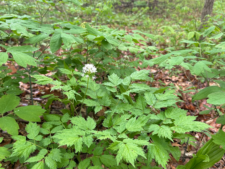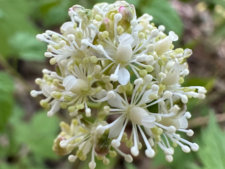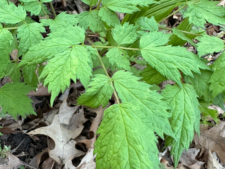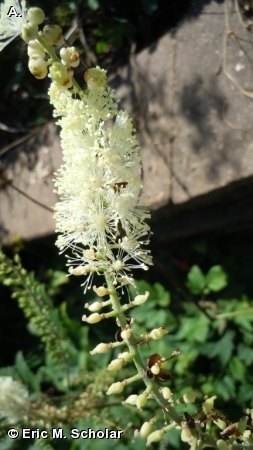
Red Baneberry
Actaea rubra
BUTTERCUP FAMILY (Ranunculaceae)
 Identification
Identification
- Flowering time - May, June
- Rare in moist upland woods at FF and NW
- Showy cluster of white flowers with many 'spiky' stamens
- Leaves divided into groups of 3 leaflets
- Bright red berries
A bushy plant with large, highly divided leaves and a short, thick, rounded cluster of small white flowers in leaf axils or at stem ends. The branched, 1-3 ft. stems of this perennial have two or three large compound leaves, each divided into threes (B,D,F). The leaflets are deeply saw-toothed. The small white flowers in dense globular clusters are found above the leaves (D,E). The berries are red or rarely white and are on a slender stalk each containing 9-16 seeds (C). Each flower has 10 petals which tend to be squared at the tip. Photo (A) of the flowers was taken after the petals have fallen off. The showy radiating structures are the remaining white stamens. Photo (E) shows the complete flower.
Marjorie Garabrandt, in her survey of native plants of Fontenelle Forest and Neale Woods, lists this plant as rare at both sites. It grows in moist, shady areas in upland woodlands.
Flowering occurs in May and June.
The berries of Red Baneberry (and White Baneberry) are very poisonous if ingested and may affect the nervous system. European species have fatally poisoned children, but baneberries are not reported to have caused death to humans or livestock in the United States.
Other common names for this plant include Cohosh, Red Cohosh, Necklaceweed, Snakeberry, and doll’s eyes.
Native Americans of this area used a tea of the leaves for various medicinal purposes.
The content of NatureSearch is provided by dedicated volunteer Naturalists of Fontenelle Forest who strive to provide the most accurate information available. Contributors of the images retain their copyrights. The point of contact for this page is: Eric Scholar.

